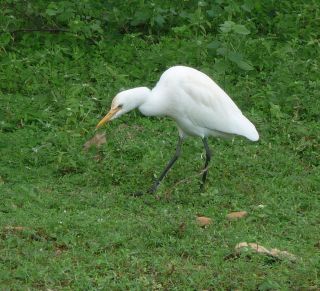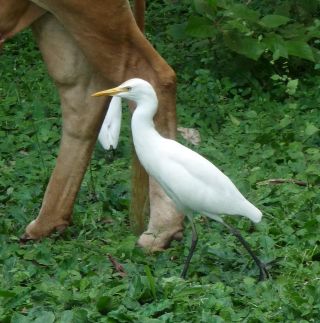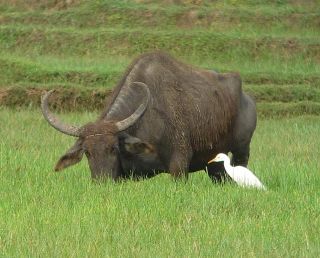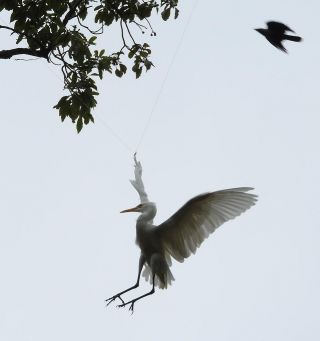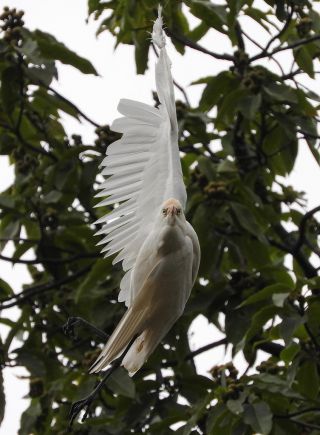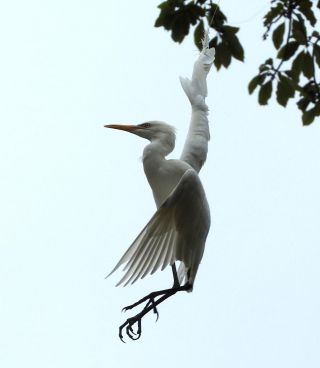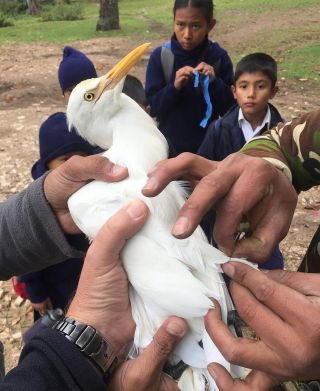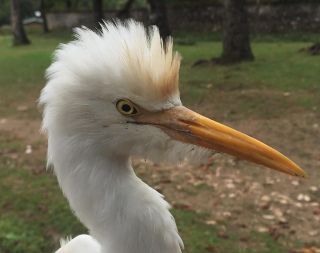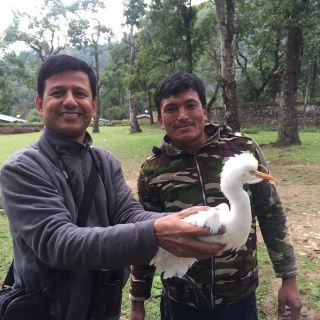Cattle Egret in non-breeding plumage © Mark Brazil
The Bird that Saved Me from Death
By Mark Brazil | Nov 30, 2015
Cattle Egrets strike me as practical and workmanlike water birds. They are cowboys of the avian world; they stomp about and indelicately poke around in search of food and they think nothing about hopping up onto the back of either a docile domestic beast or a wilder creature and riding it until it scares up the next meal from swamp, marsh or grassland. Their scientific name, Bubulcus ibis, hints at these habits, as Bubulcus means herdsman. Cattle Egrets don’t go in for the effete fine lacy plumes that adorn their delicate close avian relatives such as the Old World Little Egret and the New World Snowy Egret. Those birds are rendered supremely elegant during their breeding season when their frothy plumes seem to envelop them in delicacy, as if wearing a lambent halo of finery. Instead, come spring, the Cattle Egret’s cold white winter plumage takes on a strange buffy- or rusty-orange tinge. It appears as if it wears fine iron mail coveralls that have been out in the spring rain too long. While some egrets are all about grace and show, the Cattle Egret gets down and dirty in the mud and amongst the livestock.
The Cattle Egret is a tough bird: a generalist, a commensal species, a wanderer. In Japan, it occurs mainly in the south and west. It keeps to warmer regions mostly, but then some of them move northwards through the Japanese archipelago following the wave of spring warmth, or perhaps responding to the flush of spring growth and to the sudden abundance of frogs and of large insects such as grasshoppers. I have, on rare occasions even encountered individuals as spring overshooting vagrants that have mistakenly wandered as far north as Hokkaido.
Globally, the Cattle Egret is renowned for two things. First for the broad span of its range stretching right across Africa, Australasia and the warmer parts of Europe, and second for its remarkably rapid (some might say explosive) westward expansion out of Africa into the Americas and southeast from Asia into Australasia. Following its arrival in northeastern South America in 1877 it has spread southwards and northwards, with the ‘herdsman’ establishing itself in cattle rearing country. It reached northwards into the USA in 1941, reached Canada by 1962 and within 50 years of its arrival in North America it had become one of the most abundant herons in the region. Meanwhile it was also spreading southwards through the cattle ranching countryside of Brazil and Argentina, becoming common throughout much of South America and it soon reached Patagonia. Vagrant Cattle Egrets have even reached the sub-Antarctic islands with surprising regularity.
The Cattle Egret may be best known for its habits of following (even riding on) farm animals, particularly cattle and water buffalo, and waiting for them to flush bite-sized bugs, and almost as well known for its astonishingly rapid global expansion out of Europe, Asia and Africa into the Americas and Australasia, but I doubt that its life-saving abilities have been trumpeted before.
When I say “life-saving” I really mean it. Actually, a Cattle Egret saved my life. At least that is what my Nepali driver said, and given the circumstances I am not going to argue with him. I have been enjoying living on borrowed time ever since.
It happened like this, and only a month ago. I was birdwatching on Phulchowki Mountain just outside Kathmandu, Nepal, with local birding expert and BirdingPal Shankar Tiwari (look him up if you ever plan to go birding in Nepal, he is fantastic). We had made a couple of stops at lower elevations to look for common lowland species, and had already noted the presence of Cattle Egret in the post harvest rice fields, but because of their mundanity we had thought nothing more of them. After all, they are widespread, common and easily seen in many areas. Then, after heading a little higher into the hills, and while we were watching birds outside the Godavari Botanical Gardens, a local man stopped us and alerted us to a surprising sight – a cold white, almost angelic-looking Cattle Egret in mid air. I don’t mean flying, I mean suspended! For the briefest of moments the situation seemed almost magical; there, in mid air, was a bird defying gravity and levitating, but then the harsher reality became powerfully clear.
Kite-flying is a very popular hobby for children in many Asian countries, including Nepal, and many a flight of these small, locally-made paper or plastic kites ends in tragedy with the child crying and the kite stranded out of reach high in a tree with its string draped across branches and telephone wires alike. Our hapless Cattle Egret had not only struck one such kite string stretched tight between two trees, but had somehow twisted that string around its wing tip thereby entangling itself completely in an unbreakable, single-stranded web. That single thread was offering it a terminal embrace. The bird’s intermittent struggles had done nothing more than increase the number of turns of the kite string around its primary feathers, and it was dangling hopelessly, far out of reach above our heads.
We were all non-plussed. We wanted to effect a rescue, but how? Fortunately, Asia is home to a very dependable, lengthy and relatively light construction material – bamboo. Not far off a stack of long bamboo scaffolding poles offered up a possibility. With some struggling on our parts we managed eventually to pick up a pole and raise it vertically. All three of us, our driver, Shankar and me, grasped the bamboo pole’s heavy base and raised it on end as high as we could above our heads. We hoped to snag the kite string with the pole’s tip and so bring the martyred egret down to earth. Alas, the pole and our height combined still left us a few feet short and it was the pole that came crashing back down. What next?
Our resourceful driver then revealed another skill as he deftly shimmied up the tree nearest the bird, secured himself on a high branch, and beckoned to us for the pole, which we passed up to him. The added height afforded by the tree was a definite bonus, but now the angle for the bamboo pole was much more difficult and the situation was made harder by the fact that from where he was perching our driver could not see the entangling string, so we had to shout directions up to him. Again our joint efforts fell just short and still the bird dangled, fluttering occasionally as it twisted and turned helplessly on the light breeze.
Just reaching the kite string was not going to be enough to rescue the egret. We needed another approach. Like Monty Python’s Piranha Brothers we finally reached a turning point when we hit upon “the other, other” plan, and this time it would work. At our request local children, intrigued by our very visible and somewhat bizarre efforts, ran off to a nearby house and came back with a sickle. With the handle of that blade lashed carefully to the tip of the pole it became possible, not only to reach the string, but even to saw through it.
Severing the taut string released one end at least and the egret slowly descended to the ground. Then it took only a matter of minutes before we had disentangled the bird from the kite string. Fortunately, it seemed fit and well, despite its pathetic ordeal. No doubt the muscles of its wing must have been strained while it dangled and struggled, especially those of the digits to which the primary feathers are attached. After examining it carefully, and after taking celebratory photographs commemorating its rescue, I set it down and released it and we were delighted to see it shuffle, straighten its feathers, then run off. With a jump and a short flight it reached the top of the overgrown wall surrounding the botanical garden, and then it was gone.
I cannot say that we thought no more of the matter, because in reality we talked about it repeatedly as we continued our way up the mountain. After all said and done, it had been quite an adventure. But by now you may be questioning the title of my story, as it was clearly us who had saved the life of a bird, not the other way round as my headline suggests. However, the egret’s rescue did not conclude the day’s adventures.
In the pleasure of a day replete with bird sightings we began to forget about our rescue of the egret and we may then have thought nothing more about it at all had another extraordinary event not transpired and cemented it in place in our minds.
We were nearer the top of the mountain now. We had made numerous stops for birds along the way, but with limited time we had finally decided to press on by jeep to the very top of the mountain where there is a permanent military encampment. I should point out at this stage that the dirt track was barely one vehicle wide as it wrapped around the mountainside. To our right the mountain rose steeply, almost vertically, while to our left the land fell away precipitately down through forest at a scarily steep angle. I began to wonder what we would do if we met another vehicle coming downhill. Then it happened.
We turned a corner and as we straightened I saw a large truck, a military water tanker, heading straight towards us down the narrow jeep track. Even at the initial distance I could see the truck driver’s facial expression and knew immediately from his body language that something was definitely up, or, given our vulnerable position directly in his path, most likely down, down, down. I knew in an instant that the truck’s brakes had failed and that if it hit us head-on we would be pushed off the track and down the awfully steep mountainside. It seemed that after several decades of frequent travel and several very close shaves my number was finally being called. I had visions of a Terry Pratchettian Death figure, complete with his black cloak and finely honed scythe, racing towards us on his white horse and closing the final gap between the entrancing light of this world and the mysterious darkness of the next.
The vision probably took only milliseconds, but it seemed to last for an age. However, as I watched as helplessly as our egret had dangled, I saw the truck driver react and knew then that mercifully the tanker must have been empty. Had it been carrying a full load of many tons of water, the outcome would have been very different and Death would have been hastening us on to the final journey of all.
The army driver yanked at his truck’s heavy steering wheel, and was no doubt battling down through his gears at the same time. He forced the bouncing truck onto the very rough inside edge of the track. That not being sufficient to do more than slow it, the driver than ran his truck scraping and bumping against the rock wall rising to his left (our right). Mercifully the heavy truck, which would so easily have pushed us off the track to our doom, came to a grinding, and rather destructive halt wedged against the rock wall.
Phew! We were safe; disaster had been averted. We had been snatched from Death’s approaching grasp and from that moment onwards we have been living on borrowed time.
In the land of Karma we surmised that something in our past lives must have saved us. Our driver was quick to verbalize it –the egret, whose life we had saved just that morning, had almost immediately returned the favour and saved ours!
I have been in various scrapes over the years that have led me to think “how on Earth did I get into this mess, and how will I get out of it?” and forced me to confront my own concerns about the dangers of a career as a field naturalist. I have known, and known of, others who have been seriously injured or killed while watching birds around the world, so I have been not unaware of the risks I take on my travels. It is a relief to know now that bird watching may also save lives. However, I hope I don’t come so close again to disaster – until my very final journey – unless there are plenty of birds around to save me!
Outro
Author and naturalist Dr Mark Brazil has written his Wild Watch column continuously since April 1982. All Wild Watch articles dating back to 1999 are archived here for your reading pleasure. A collection of Mark’s essays The Nature of Japan has been published and is also available from www.japannatureguides.com

